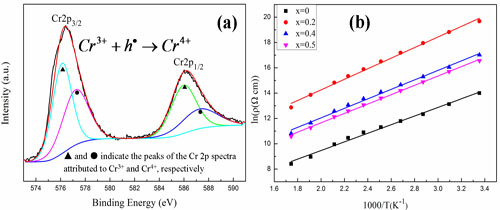Researchers Reveal the Mechanism of Electrical Conductivity Anomaly in YCr1-xMnxO3 NTC Ceramics
Editor: | Mar 20,2014
Negative temperature coefficient (NTC) thermistors are thermally sensitive resistors whose resistance decreases with increasing temperature. They are widely used in various industrial and domestic applications, such as temperature measurements and controls, temperature compensation and the suppression of in-rush current.
YCrO3 perovskites have received broad attention due to their magnetic and electronic properties, especially the promising applications as high temperature electrodes, thermoelectric and magnetoelectric materials. In particular, YCr1-xMnxO3 (0≤x≤0.5) having an orthorhombic perovskite structure, has been considered as a candidate for NTC thermistor applications. However, little physical and chemical information is available on YCr1-xMnxO3, particularly on its electrical conduction mechanism.
Professor CHANG Aimin's group from Xinjiang Technical Institute of Physics & Chemistry (XTIPC) of the Chinese Academy of Sciences, discovered electrical conductivity anomaly of YCr1-xMnxO3 NTC ceramics, and revealed the mechanism of electrical conductivity anomaly for these ceramics by using defect chemistry theory combination with X-ray photoelectron spectroscopy analysis. The major carriers in YCrO3 are holes. The Mn ions act as an n-type dope, and partly compensate for the effect of metal vacancies, thus leading to an increase in the resistivity. The Mn4+ ions increase as the Mn content increases from 0.2 to 0.5, which promote the rise in charge carriers and the electron hopping, thereby resulting in a decrease in the resistivity (Fig.1). The proposed conduction mechanism will provide theoretical foundation for designing new NTC thermistor materials by controlling atmosphere and doping ions.

Fig. 1 (a) XPS spectra of Cr 2p regions of YCrO3 ceramics. (b) Relationship between lnρ and 1000/T for the YCr1-xMnxO3 NTC thermistors(image by XTIPC).
The research results have been published in Applied Physics Letters,104, 102109 (2014).
This work was supported by the National Natural Science Foundation of
附件下载:
 (86) 991-3838931
(86) 991-3838931 lhskj@ms.xjb.ac.cn
lhskj@ms.xjb.ac.cn (86)991-3838957
(86)991-3838957 40-1 Beijing Road
Urumqi, XinjiangChina
40-1 Beijing Road
Urumqi, XinjiangChina